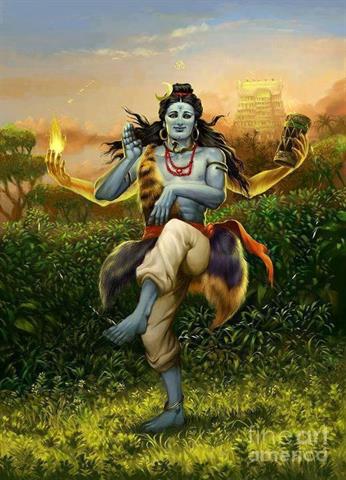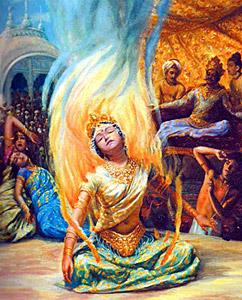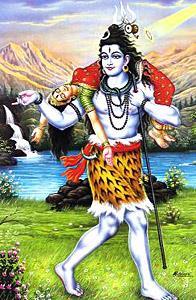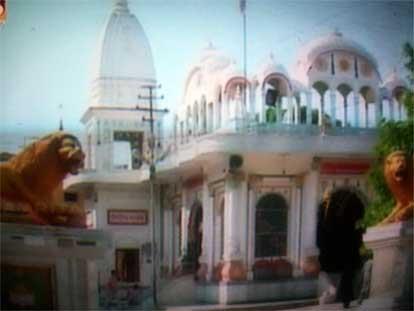DEVI SATI
Contents
· Introduction
· Birth and Early Life
· Marriage
· Daksha’s anger
· Daksha’s Yagna
· Sati’s reception
· Shiva’s anger
· Shiva’s grief
· Shakti peethas
· In the Ramacharitamanas
· Rebirth
· Kotiyoor Vysakha Mahotsavam
· Daksheshwar Mahadev Temple
· List of Shakti Peethas
· Conclusion

Introduction
Sati is a Hindu Goddess, who was the first consort of Lord Shiva. She is an aspect of Adi Parashakti and is also known as Dakshayani, being the daughter of Daksha. The capital of the kingdom of Daksha is Kankhal near modern day Haridwar (Mayapuri as mentioned in the Vedas and Puranas) where the Daksha Prajapati Mandir has been constructed. She is worshipped by all Hindu women for the long life of their husbands. For the sake of loyalty and devotion to her husband, Goddess Sati burnt herself in the funeral pyre. The act in which a Hindu widow would burn herself on her husband’s funeral pyre in bygone days is named after her and was referred to as ‘Sati’. Sati took birth to play the role of bringing Shiva away from ascetic isolation to participate creatively in the world.
Birth and Early life
According to Padma Purana and Vishnu Purana, Lord Brahma created Daksha from his right thumb. Daksha was married to Prasuti, who was the daughter of Svayambhuva Manu and Shatarupa. They had 24 daughters of whom Sati was one. It is said that when they desired a daughter, Lord Brahma advised them to meditate on Goddess Adi Parashakti. Giving up royal pleasures and robes and surviving heat, cold, rain and harsh weather they sat in a forest and performed penances. After a long time, the Goddess appeared before them and granted them their boon. They asked her to take birth as their daughter. The Goddess agreed and was subsequently born as their daughter, whom they named Sati, meaning truth. From birth, Sati adored the tales and legends of Lord Shiva, and as she grew up, her only ambition was to secure Him as her husband.
Marriage
As Sati grew up into a young and beautiful girl, she decided to seriously pursue her goal in making Lord Shiva her husband. She gave up all luxuries and retired to the forest to devote herself wholeheartedly to the contemplation and worship of Lord Shiva. She gradually gave up food and subsisted on one leaf a day, while performing rigorous penances. Later she gave up even that due to which she secured the name Aparna. Finally, pleased with her sincerity and devotion, Shiva blessed her and agreed to marry her. Sati was overjoyed and returned to the palace to inform the joyous news and await the advent of Lord Shiva as the bridegroom.
Daksha’s anger
Daksha being a King received proposals from rich and brave Kings for Sati’s hand and he was furious when Sati refused and expressed a desire to marry Shiva. He considered Shiva an ascetic with matted, unkempt hair, who was always found in cremation grounds and disliked him intensely. Clad in tiger skin, smeared with ashes from the cremation ground and snakes around his neck, Daksha could not imagine his beautiful and graceful daughter marrying such a man. But Sati was adamant and finally, Daksha had no choice but to agree to his daughter’s wishes and the wedding was duly performed without much fanfare and celebrations, after which Sati proceeded to Kailash with Shiva on Shiva’s vehicle Nandi. Shiva was a kind and loving husband and Sati spent her days in devoted service to her husband.
Daksha’s yagna
Meanwhile, Daksha decided to organise a Yagna and invited everyone to participate in it with the exception of Shiva and Sati. Sati learnt about the yagna and persuaded Shiva to accompany her to the Yagna reasoning with him that as she was their daughter she did not require a formal invitation. But Shiva refused stating that they had not been invited. However seeing Sati’s earnestness and love for her parents, Shiva allowed her to go escorted by Shiva’s Ganas to her father’s kingdom.
Sati’s reception
Unfortunately when Sati arrived full of eager anticipation to meet her parents and sisters, Daksha was annoyed at her arrival and began abusing her in front of the assembled personage. Sati tried to pacify him, but he began disparaging remarks against her husband, Shiva. She realised that her beloved husband Shiva was only being abused because he was married to her. She was the cause of this dishonour to her husband. Loathing her father for his mentality, Sati prayed that she should be born in future to a father whom she would respect and who would honour Shiva. Then she invoked her yogic powers and creating a fire jumped into it performing self-immolation.

Shiva’s anger
On hearing the terrible news, Shiva was grief stricken and angry. He then pulled two locks of his hair and threw it on the ground. From them arose Veerabhadra, Shiva’s destructive form, looking dark and fearsome with eight hands holding weapons and his spouse Bhadrakali the Goddess’s violent form with eighteen hands holding weapons. They were assisted by eight other ferocious looking Goddesses namely Kali, Katyayani, Chamundi, Ishaani, Bhadra, Mundamardini, Vaishnavi and Twarita and all of them together began to wreak havoc on the gathering. Daksha was decapitated and in the rampage, the Yajnashaala was devastated. Later Shiva forgave everyone and restored back to life most of them who were slain. Daksha’s head was replaced with that of a goat, and the Yajna was duly completed. Having learnt his lesson, Daksha remained a lifelong devotee of Lord Shiva.
Shiva’s grief

But Shiva was torn with grief on seeing the half burned corpse of his beloved wife Sati. The other Gods called Lord Vishnu to help in calming Shiva. Lord Vishnu appeared and tried to pacify him but in vain. Unable to part with her, Shiva carried her corpse and wandered hither and thither. Some legends state that Shiva performed the Cosmic dance of destruction (Thandava) across all creation carrying Sati’s lifeless body. Other legends state that Lord Vishnu dismembered Sati’s lifeless body into 51 parts with his Sudarshan Chakra following which Shiva regained his equanimity and calmness. Her body parts (51 in number) fell in places which came to be known as Shakti Peethas. The blood drops from Sati’s body which fell on the earth, resulted in small peethas like Bindudham which came into existence. It is said that even in the present times Lord Shiva roams around as Kala Bhairava and protects the Shakti Peethas.
Shakti Peethas
At all the Shakti Peethas, Goddess Shakti is accompanied by her consort Lord Bhairava. The 51 Peethas correspond to the 51 alphabets in Sanskrit and are scattered in the entire Indian subcontinent which includes along with India, the countries of Sri Lanka, Nepal, Bangladesh, Tibet, Pakistan and Bhutan. The most sacred Peethas are considered the ones at Kamakhya, Gaya and Ujjain as they symbolise the three important aspects of the Goddess namely Creation (Kamarupa Devi), Nourishment (Mangalagauri or Sarvamangala Devi) and Annihilation (Mahakali Devi). The Daksha Yagna and the self-immolation of Sati are thus of immense significance in shaping the ancient Sanskrit literature and Shaivism resulting in the union of Shiva and Parvati leading to the birth of Ganesha and Kartikeya. It has resulted in the birth of the Shakta sect and Shaktism one of the primary schools of devotional Hinduism which focuses on all worship of Shakti as the Supreme Brahman herself and as the dynamic and feminine aspect of the Supreme Divine, while the worship of Shiva denoting the masculine aspect of divinity, is relegated to an auxiliary role. Shaktas are tantric and non tantric and use chants, holy diagrams, real magic, rituals and yoga to call forth cosmic forces. It is said that nowhere in the religious history of the world is there such a female oriented system where the Goddess is conceived as the Supreme Ultimate Godhead, source and embodiment of all creation as well as the energy that governs and animates it.
In the Ramacharitamanas
According to legends in the Treta Yuga, Shiva went to Rishi Agastya along with Sati. Sage Agastya related the story of Lord Rama to the couple. Shiva got a glimpse of Rama which overwhelmed him with love and joy. Sati could not comprehend the divinity of Rama and wondered why Shiva was so enamoured by a human being when Shiva himself was divine. Sati did not mention her feelings of scepticism to Shiva, but Shiva being omniscient knew Sati’s doubts and feelings. He then asked Sati to verify for herself. Sati then decided to test Rama and she approached him in the form of Sita. However, Rama recognised her and knew her thoughts and doubts approached her, introducing himself and then asking her about Shiva’s whereabouts and the reason for her moving around alone without her husband. She had a vision in which she found Rama, Sita and Lakshmana walking in front of her and Lord Rama spread in all directions along with various deities with all creation encapsulated in Him. When she opened and closed her eyes, everything vanished. Awe stricken and full of reverence, she returned to Shiva.
Rebirth
Sati was reborn as Parvati, the daughter of Himavan, who revered and respected Shiva. She sought and secured Shiva as her husband, and this legend is described in detail in the Puranas, in Tantra literature and Kalidasa’s lyrical epic Kumarasambhavam.
Kotiyoor Vysakha Mahotsavam
It is a 27 day yearly pilgrimage celebrated at Kotiyoor Kerala at the Ikkare Kotiyoor temple, on the west bank of the Vavali river, in the monsoon season in the Hindu month of Vysakha – (May/June to June/July) to commemorate the mythology of Daksha Yagna. The Shiva linga at this temple is Swayambhu or self manifested. It is believed that Sati self immolated in this region. Shankaracharya is said to have classified the poojas and rituals performed here.
Daksha Prajapati Mandir or Daksheshwar Mahadev temple

It is one of the most ancient Shiva temples at Kankhal in Haridwar and according to mythology, the seat of the Daksha Yajna. There is a pit within the grounds of the temple which marks the exact location of the sacrificial fire. The temple stands a tribute to the sacrifice of Mata Sati. Later, on the site of the Yajna and Sati’s sacrifice, the Daksha Mahadev temple or Shri Daksheshwar temple was built initially by Queen Dhankaur in 1810, and lately reconstructed in the year 1962. At the centre of the temple, the holy Shiva idol in phallic form is situated. Thousands of devotees come from all over the world in the holy month of Shravan in August to worship in the temple. Special celebrations and prayers are performed on the holy occasion of Maha Shivaratri.
List Of Shakti Peethas with their names and forms
|
Sr. No |
Place |
State in India/Country |
Body Part or Ornament |
Shakti |
Bhairava |
|
1 |
Amarnath, from Srinagar through Pahalgam 94 km by Bus, Chandanwari 16 km by walk |
Jammu and Kashmir |
Throat |
Mahamaya |
Trisandhyeshwar |
|
2 |
Attahas village of Dakshindihi in the district of [[Birbhum] ], |
West Bengal |
Lips |
Phullara |
Vishvesh |
|
3 |
Bahula, on the banks of Ajay river at Ketugram, 8 km from Katwa, Burdwan |
West Bengal |
Left arm |
Goddess Bahula |
Bhiruk |
|
4 |
Bakreshwar, on the banks of Paaphara river, 24 km distance from Siuri Town [a district headquarter], district Birbhum, 7 km from Dubrajpur Rly. Station |
West Bengal |
Portion between the eyebrows |
Mahishmardini |
Vakranath |
|
5 |
Bhairavparvat, at Bhairav hills on the banks of Shipra river in the city of Ujjaini.Local People call this temple as Gadkalika. |
Madhya Pradesh |
Elbow |
Avanti |
Lambkarna |
|
6 |
Bhabanipur, located in the Upazilla of Sherpur, Bogra, Rajshahi Division. Also located at Karatoyatat, it is about 28 km distance from the town of Sherpur. |
Bangladesh |
Left anklet (ornament) |
Aparna |
Vaman |
|
7 |
Chhinnamastika Shaktipeeth at Chintpurni, in Una District of Himachal Pradesh |
Himachal Pradesh |
Feet |
Chhinnamastika |
Rudra Mahadev |
|
8 |
Gandaki, Pokhara about 125 km on the banks of Gandaki river where Muktinath temple is situated |
Nepal |
Temple |
Gandaki Chandi |
Chakrapani |
|
9 |
Goddess Bhadrakaali on banks of Godavari in Nasik city |
Maharashtra |
Chin (2 parts) |
Bhramari |
Vikritaksh |
|
10 |
Hinglaj (Or Hingula), southern Baluchistan a few hours North-east of Gawadar and about 125 km towards North-west from Karachi |
Pakistan |
Bramharandhra (Part of the head) |
Kottari |
Bhimlochan |
|
11 |
Jayanti at Nartiang village in the Jaintia Hills district. This Shakti Peetha is locally known as the Nartiang Durga Temple. |
Meghalaya |
Left thigh |
Jayanti |
Kramadishwar |
|
12 |
Jessoreswari, situated at Ishwaripur, Shyamnagar Upazila, Khulna Division. The temple complex was built by Maharaja Pratapaditya, whose capital was Ishwaripur. |
Bangladesh |
Palms of hands and soles of the feet |
Jashoreshwari |
Chanda |
|
13 |
Jwalaji, Kangra from Pathankot alight at Jwalamukhi Road Station from there 20 km |
Himachal Pradesh |
Tongue |
Siddhida (Ambika) |
Unmatta Bhairav |
|
14 |
Kalipeeth, (Kalighat, Kolkata) |
West Bengal |
Right Toes |
Kalika |
Nakuleshwar |
|
15 |
Kalmadhav on the banks of Shon river in a cave over hills near to Amarkantak |
Madhya Pradesh |
Left buttock |
Kali |
Asitang |
|
16 |
Kamgiri, Kamakhya, in the Neelachal hills near Guwahati |
Assam |
Genitals |
Kamakhya |
Umanand |
|
17 |
Kankalitala, on the banks of Kopai River 10 km north-east of Bolpur station in Birbhum district, Devi locally known as Kankaleshwari |
West Bengal |
Bone |
Devgarbha |
Ruru |
|
18 |
Kanyashram of Balaambika - The Bhagavathy temple in Kanyakumari, the southernmost tip of mainland India, Tamil Nadu (also thought to be situated in Yunnan province, China) |
Tamil Nadu |
Back |
Sarvani |
Nimish |
|
19 |
Karnat, Brajeshwari Devi, Kangra |
Himachal Pradesh |
Both ears |
Jayadurga |
Abhiru |
|
20 |
Kireet at Kireetkona village, 3 km from Lalbag Court Road station under district Murshidabad |
West Bengal |
Crown |
Vimla |
Sanwart |
|
21 |
Locally known as Anandamayee Temple. Ratnavali, on the banks of Ratnakar river at Khanakul-Krishnanagar, district Hooghly |
West Bengal |
Right Shoulder |
Kumari |
Shiva |
|
22 |
Locally known as Bhramari Devi. In Jalpaiguri near a small village Boda on the bank of river Teesta or Tri-shrota (combination of three flows) mentioned in Puranas |
West Bengal |
Left leg |
Bhraamari |
Ambar |
|
23 |
Manas, under Tibet at the foot of Mount Kailash in Lake Mansarovar, a piece of Stone |
Tibet |
Right hand |
Dakshayani |
Amar |
|
24 |
Manibandh, at Gayatri hills near Pushkar 11 km north-west of Ajmer.People know this temple as Chamunda Mata Temple. |
Rajasthan |
Wrists |
Gayatri |
Sarvanand |
|
25 |
Mithila, near Janakpur railway station on the border of India and Nepal |
Nepal |
Left shoulder |
Uma |
Mahodar |
|
26 |
Nainativu (Manipallavam), Northern Province, Sri Lanka. Located 36 km from the ancient capital of the Jaffna kingdom, Nallur. The murti of the Goddess is believed to have been consecrated and worshipped by Lord Indra. Lord Rama and Ravana of the epic Ramayana have offered obeisances to the Goddess. Nāga and Garuda resolved their longstanding feuds after worshipping this Goddess. |
Sri Lanka |
Silambu (Anklets) |
Indrakshi (Nagapooshani / Bhuvaneswari) |
Rakshaseshwar (Nayanair) |
|
27 |
Nepal, near Pashupatinath Temple at Guhyeshwari Temple |
Nepal |
Both Knees |
Mahashira |
Kapali |
|
28 |
On Chandranath hill near Sitakunda station of Chittagong Division. The famous Chandranath Temple on the top of the hill is the Bhairav temple of this Shakti Peetha, not the Shakti Peeth itself. |
Bangladesh |
Right arm |
Bhawani |
Chandrashekhar |
|
29 |
Panchsagar Near Lohaghat (in Champawat District of Uttarakhand) nearly 100 km from nearest railway station Tanakpur. |
Uttarakhand |
Lower teeth |
Varahi |
Maharudra |
|
30 |
Prabhas, 4 km from Veraval station near Somnath temple in Junagadh district. |
Gujarat. |
Stomach |
Chandrabhaga |
Vakratund |
|
31 |
Prayag near Sangam at Allahabad |
Uttar Pradesh |
Finger |
Lalita |
Bhava |
|
32 |
Present day Kurukshetra town or Thanesar ancient Sthaneshwar |
Haryana |
Ankle bone |
Savitri/BhadraKali |
Sthanu |
|
33 |
Ramgiri, at Chitrakuta on the Jhansi Manikpur railway line |
Uttar Pradesh |
Right breast |
Shivani |
Chanda |
|
34 |
Sainthia, locally Known as Nandikeshwari temple. Only 1.5 km from the railway station under a banyan tree within a boundary wall, Birbhum district |
West Bengal |
Necklace |
Nandini |
Nandikeshwar |
|
35 |
Sarvashail or Godavaritir, at Kotilingeswar temple on the banks of Godavari river near Rajamundry |
Andhra Pradesh |
Cheeks |
Rakini or Vishweshwari |
Vatsnabh or Dandpani |
|
36 |
Naina devi |
Himachal Pradesh |
Eyes |
Mahishmardini |
Krodhish |
|
37 |
Shondesh, at the source point of Narmada River in Amarkantak |
Madhya Pradesh |
Right buttock |
Narmada |
Bhadrasen |
|
38 |
Shri Parvat, near Ladak, Jammu and Kashmir. Another belief: at Srisailam in Shriparvat hills under Kurnool district |
Andhra Pradesh |
Right anklet (ornament) |
Shrisundari |
Sundaranand |
|
39 |
Shri Shail, at Joinpur village, Dakshin Surma, near Gotatikar, 3 km north-east of Sylhet town |
Bangladesh |
Neck |
Mahalaxmi |
Sambaranand |
|
40 |
Shuchi, in a Shiva temple at Suchindrum 11 km on Kanyakumari Trivandrum road |
Tamil Nadu |
Upper teeth |
Narayani |
Sanhar |
|
41 |
Sugandha, situated in Shikarpur, Gournadi, about 20 km from Barisal town, on the banks of Sonda river. |
Bangladesh |
Nose |
Sugandha |
Trayambak |
|
42 |
Udaipur, Tripura, at the top of the hills known as Tripura Sundari temple near Radhakishorepur village, a little distance away from Udaipur town |
Tripura |
Right leg |
Tripura Sundari |
Tripuresh |
|
43 |
Ujaani, 16 km from Guskara station under Burdwan district |
West Bengal |
Right wrist |
Mangal Chandika |
Kapilambar |
|
44 |
Varanasi at Manikarnika Ghat on banks of the Ganges at Kashi |
Uttar Pradesh |
Earring |
Vishalakshi & Manikarni |
Kalbhairav |
|
45 |
Vibhash, at Tamluk |
West Bengal |
Left ankle |
Kapalini (Bhimarupa) |
Sarvanand |
|
46 |
Virat, near Bharatpur |
Rajasthan |
Left toes |
Ambika |
Amriteshwar |
|
47 |
Vrindavan, near new bus stand on Bhuteshwar road within Bhuteshwar Mahadev Temple, Katyayanipeeth. Vrindavan |
Uttar Pradesh |
Ringlets of hair |
Uma |
Bhutesh |
|
48 |
Jalandhar, from Jalandhar Cantonment Station to Devi Talab. |
Punjab |
Left Breast |
Tripurmalini |
Bhutesh |
|
49 |
Baidyanath Dham |
Jharkhand |
Heart |
Jaya Durga |
Baidyanath |
|
50 |
Biraja Temple in Jajpur |
Jajpur, Odisha |
Bamonbonsham(Navel) |
Biraja |
|
|
51 |
Jugaadya,at Khirgram under Burdwan district |
West Bengal |
Great Toe |
Jugaadya |
Ksheer Khandak |
|
52 |
Pitikapureswari,at Kakinada |
Andhra Pradesh |
Conclusion
The Rudra Samhita of the Shiva Purana states that unless Shiva involved himself in the created world, there could be no continuation of species and creation. This was the reason for the birth of Sati and later Parvati. The union of Sati and Shiva allows creation to continue as Sati represents the ‘yoni’ while Shiva represents the ‘Linga’. This resulted in the Sati act in medieval times where the wife expressed her undying loyalty to her husband by joining him in the funeral pyre. According to other legends, the birth of Kartikeya to kill the demon Tarakasura needed Shiva to give up his monastic role and take over the mantle of family life. This necessitated the divine play of the birth of Sati and later on Parvati. Sati has come to embody the epitome of sacrifice and loyalty and is revered as a ‘Pativrata Stree’.
1. wikipedia.com
2. books.google.co.in
3. hindupedia.com
4. hindumythologyforgennext.blogspot.in
5. Indianmythology.com
6. freeindia.org
8. hindupedia.com
9. swami-krishnananda.org
11. krsnabook.com
